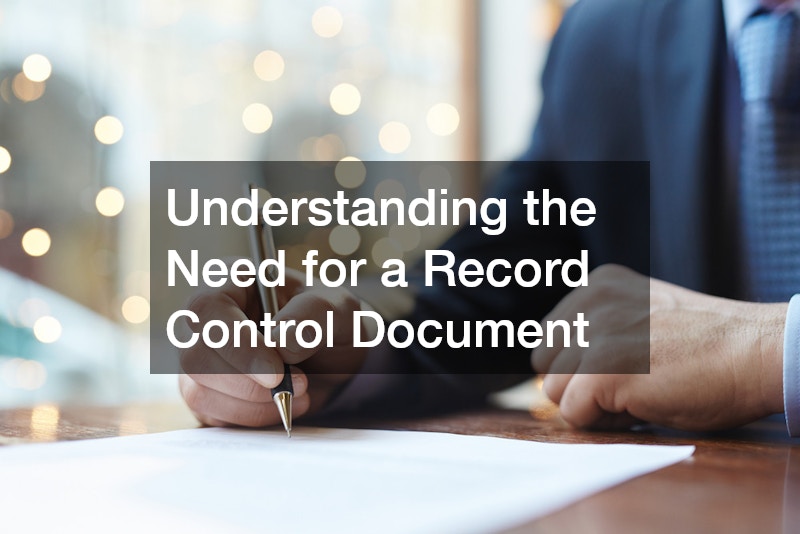Maintaining control over documentation is crucial for efficiency, compliance, and quality assurance in today’s fast-paced business environment. A Record Control Document is pivotal in managing and safeguarding these documents. This article delves into the importance of Record Control Documents and addresses some of the most frequently asked questions regarding their implementation and benefits.
Why is a Record Control Document Important?
Ensuring Compliance with Regulations
Regulatory bodies often mandate strict documentation protocols. A Record Control Document ensures adherence to these regulations, reducing the risk of legal repercussions.
In healthcare, finance, and manufacturing industries, regulatory compliance is not just a recommendation but a necessity. Proper record management helps organizations demonstrate compliance during audits and inspections, providing a clear documentation trail.
Furthermore, effective record control mitigates the risk of non-compliance penalties that can be costly and damaging to a company’s reputation. By maintaining a standardized approach to documentation, organizations can ensure that all employees are aligned with regulatory expectations. It also simplifies reporting processes, making extracting the necessary information for compliance reports easier.
Implementing a Record Control Document protects businesses from potential legal challenges. A structured documentation system allows companies to act swiftly and accurately when regulatory changes occur. Continuous monitoring and updating of these records ensure that businesses remain adaptable to evolving legal landscapes.
Improving Organization and Access to Information
With a structured approach to documentation, organizations can efficiently organize, retrieve, and manage their records, improving overall productivity and decision-making. An organized documentation system saves significant time, as employees can quickly locate and access the necessary information. This enhances collaborative efforts by ensuring team members have readily available essential documents.
Moreover, having a well-implemented Record Control Document reduces redundancy and duplication of records. It ensures a single source of truth for information, which is crucial for maintaining accuracy and consistency across the organization. This leads to better communication and minimizes errors in data interpretation, ultimately supporting informed decision-making.
Efficient record management also supports organizational agility. Companies that adapt swiftly to new challenges and opportunities in a rapidly changing business environment maintain a competitive advantage. Access to well-organized and up-to-date information enables strategic planning and fosters innovation.
Enhancing Data Security
Implementing a Record Control Document increases the security of sensitive information, protecting against unauthorized access and data breaches. Data breaches can be costly and damaging, both financially and reputationally. A coherent documentation management system acts as a safeguard by implementing stringent access controls and monitoring mechanisms.
Besides preventing unauthorized access, a well-structured Record Control Document includes data encryption and secure storage protocols. This is particularly vital given the increasing incidence of cyber threats in today’s digital landscape. By enhancing data security measures, organizations can protect sensitive information and maintain the trust of their clients and stakeholders.
Regular audits and updates of the Record Control Document ensure that security protocols remain robust and effective. By continuously evaluating and improving their documentation procedures, businesses can stay one step ahead of potential threats, mitigating risks associated with data management.
How Do You Implement a Record Control Document?
Identifying Critical Documents

Begin by determining which documents are vital for compliance, operations, and corporate knowledge. This step is crucial for effective record management. Critical documents may include financial records, contracts, HR files, and policy documents, each needing specific handling and storage requirements.
Consulting with various departments within the organization can provide insights into which documents are essential and why. Involving stakeholders encourages buy-in and ensures that all necessary documents are considered. It’s vital to categorize these documents based on their level of importance and required retention period.
Organizations can streamline their documentation processes by prioritizing critical documents and focusing resources on securing and managing the most impactful records. This approach enhances efficiency and reduces the potential for document loss or misplacement, which can harm operations and compliance.
Developing a Documentation Policy
Create a comprehensive policy outlining document creation, storage, sharing, and disposal procedures. This policy should align with industry standards and legal requirements. A well-defined documentation policy is a blueprint for consistent and efficient record handling across the organization.
The policy should detail the responsibilities of individuals involved in the document management process, ensuring accountability at each stage. It should also include procedures for document version control and archival, helping maintain a clear record of document history and changes.
Establishing a formal documentation policy fosters compliance and ensures all employees know and adhere to best practices. Regular policy reviews and updates are necessary to accommodate changes in regulatory requirements or organizational needs, safeguarding the reliability and effectiveness of the documentation system.
Utilizing Technology for Document Management
Leverage digital tools and software to automate document management processes, ensuring accuracy, traceability, and easy access to records. Advanced document management systems (DMS) simplify the storage and retrieval of records, making it easier for employees to focus on their core responsibilities rather than paperwork.
Many organizations are adopting cloud-based solutions that offer scalability and accessibility. These systems allow remote teams to access necessary documents securely from any location and enable real-time collaboration, reducing workflow delays and boosting productivity.
Integrating technology into document management improves accuracy and efficiency and supports environmental sustainability by reducing the reliance on paper-based systems. Digital solutions often come with robust security features, further protecting sensitive data from threats.
A Record Control Document is a regulatory requirement and a strategic asset that enhances an organization’s efficiency, compliance, and security. By understanding its importance and implementing it effectively, businesses can gain a competitive edge while safeguarding their information assets. Implementing a robust Record Control Document system empowers businesses to operate with increased confidence, knowing their documentation processes are reliable and secure.
